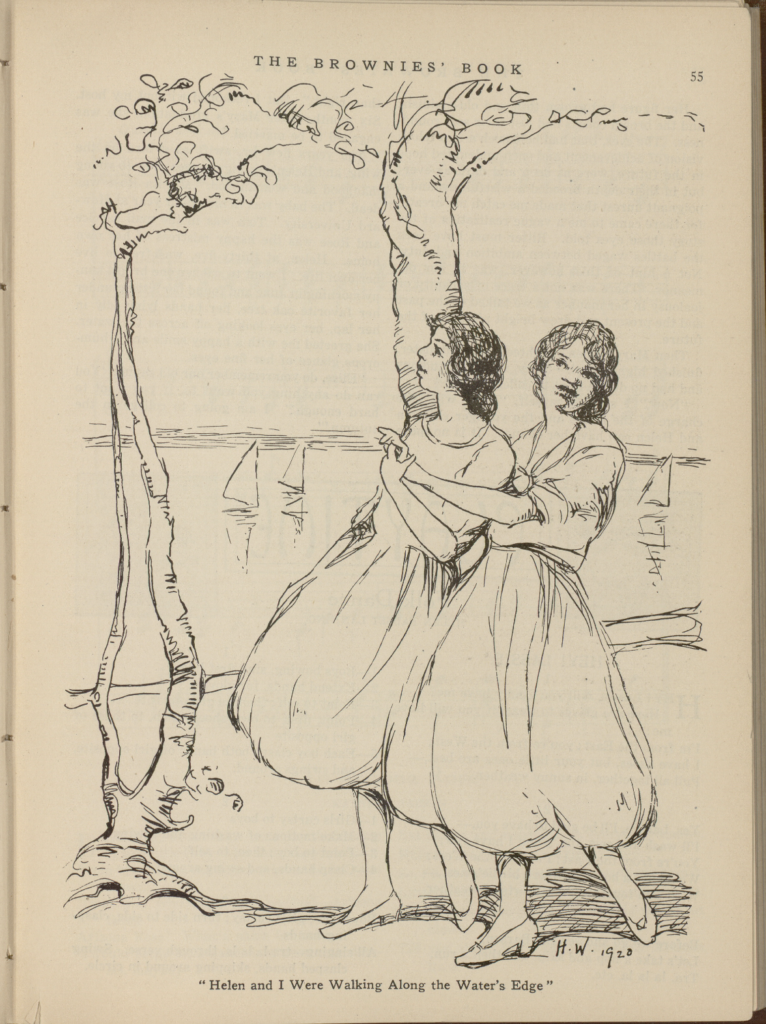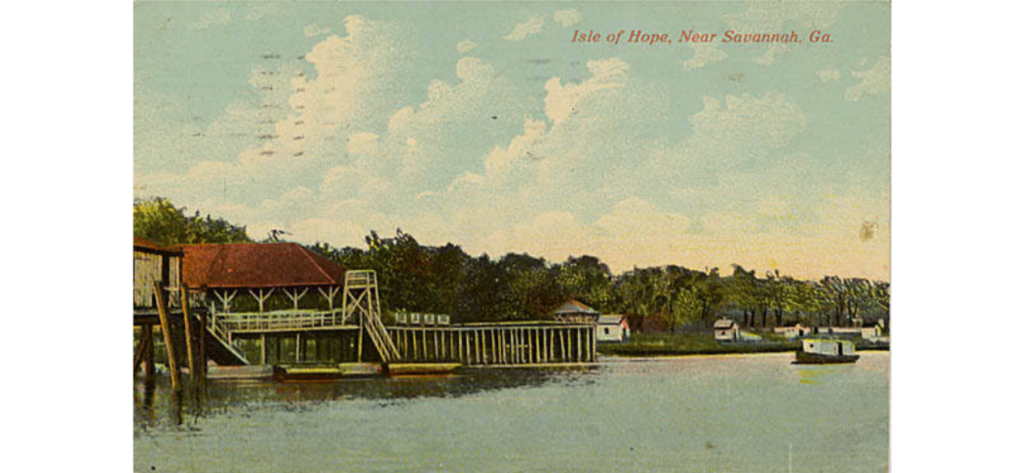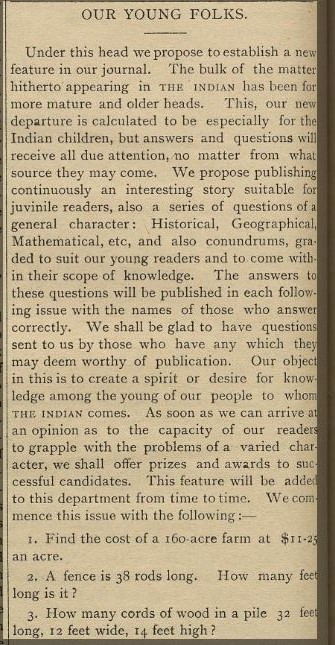A Girl’s Will
By Ella T. Madden
Annotations by Catherine Bowlin/JB

ALONG the edge of a southern forest, flows a stream called the Isle of Hope River. Void of the rush and hurry of youth, slowly, silently it flows, with an air of quiet serenity and infinite calm; along the edge of the wood, past the villages of Isle of Hope and Thunderbolt, it flows, until it is lost in the waters of the Atlantic, eighteen miles away.
In one of the weatherbeaten fisherman’s huts, which nestle under the branches of the great, gnarled, twisted, live oaks which grow along the river’s bank, lived Helen La Rose. As the keynote of the stream’s personality was repose, the most striking thing about Helen’s character was its deep unrest and consuming ambition, coupled with a high-minded, lofty idea of the infinite power of the human will.
It was the week of our graduation from Beach Institute. Helen and I were walking along the water’s edge, discussing our future with all the enthusiasm of sixteen. I could talk of nothing but the wonderful career I expected to have in college the next year, for my parents were “well-to-do,” and I was the only child. Suddenly, in the midst of gay chatter, I stopped and looked at Helen.
“Oh, I’m so sorry you can’t go, too, Helen; what fun we would have together,” I burst out sorrowfully, for pretty, ambitious, Helen La Rose was very poor. Her father had all he could do to support his wife and seven children. Helen had paid her tuition at Beach by helping Mrs. Randolph before and after school and on Saturdays.
“But I am going to college,” said Helen, in her quiet voice. “I am going to college and I am going to become the greatest teacher that ever was, if I live long enough. Booker T. Washington worked his way through Hampton and Robert Dent is working his way and so did Mr. Ross. He told me so himself.”
“Yes, but they were all boys,” I said with emphasis.
“And I’m a girl,” replied Helen, “and as smart as any boy. Dad said so. Besides,” and her eyes grew large and deep and her voice tense, “I can do anything I want to, if I want to hard enough.”
The next week was commencement. Helen was “val,” and looked sweet and girlish in her cotton voile dress, fashioned by her own little brown, work-roughened fingers. For her eager face, lit up by the great eyes and a happy,––though rather tremulous––smile, did not require a fine toilette to make it attractive.
The weeks passed and I did not see Helen again until the middle of July. We were sitting in my room and I had been showing some dresses I had bought.
“I am going to begin making my things next week,” said Helen, happily. “Daddy has let me keep all the money I have earned this summer and I have put it all in the savings bank. Just think, I have been working only nine weeks and I’ve saved forty dollars. I’ll make forty more between now and October and that will be enough for railroad fare and my first quarter’s tuition. Mrs. Randolph is going to give me a letter of recommendation to a friend of hers in Chicago and I know I’ll get work. Oh, I am so happy! And everybody is so good to me!” Helen danced around the room, hugging herself for every joy.
Early in August, Mrs. La Rose contracted malaria and died after a short illness. Mr. La Rose was heartbroken. There were six small children, ranging in age from three and a half to thirteen years. Quietly, unobtrusively, Helen took her mother’s place in the household. She did not allow even her father to realize what the sacrifice of her plans meant to her. She cooked and scrubbed and washed and ironed and cared for her swiftly aging father and little brothers and sisters with loving devotion. The little house was spick and span, the children happy and contented; and Mr. La Rose, grown suddenly old, became as calm and placid as the river that flowed past his door.

Four years passed and I received the degree of A. B. and soon after was appointed teacher of English in the high school. I lost no time in looking up my old school chum and telling her of my good fortune. She met me with a glad cry of welcome and rejoiced in her old, frank, exuberant way over my success. But after the first few moments of greeting, I could not help noticing the change in her appearance.
Her figure had grown thin and old-maidish; and the brown cheeks had lost their soft roundness. The eyes, that had held such a marvelous vision of achievement and such undaunted hope in the future, were as deep and dark as ever; but in their depth brooded a wistfulness and a poignant unrest that made me catch my breath, for there came to me a vague realization of the story those eyes told. Bitter must have been the battles waged between ambition and duty. Not a hint of this, however, was in her demeanor. There was not a trace of self-pity or jealousy in her manner as we talked of the past and the present and drew bright pictures of the future.
Then Mary, Helen’s eighteen-year-old sister, finished high school. Mary was not studious and had no desire to go to college.
“Now,” I said to myself, “Mary will take charge of the house and the younger children and Helen can have her chance. It is no more than right.” But I reckoned without my host. Six months after Mary’s graduation, she was engaged to be married.
The years flew by, swift as a bird on the wing, and Helen’s young charges grew to young manhood and womanhood. Mr. La Rose was dead. The baby was in his senior year at Howard University. Tom was in the mail service and Rose was the happy mistress of her own home. Helen, at thirty-five, was free to live her own life. I went to see her one bright sunny morning in June and found her sitting under her favorite oak tree, her hands lying idly in her lap, her eyes looking off across the water. She greeted me with a happy smile and a humorous glance of her fine eyes.
“Elise, do you remember our old saying, ‘You can do anything you want to, if you want to hard enough?’ I am going to college in the autumn!”
Madden, Ella T. “A Girl’s Will.” The Brownies’ Book 1, no. 2 (February 1920): 54-56.
Contexts
This story demonstrates the need for intersectional environmentalism. The connection between Helen (a poor Black woman) and the natural world should not be overlooked if teaching this story. Helen’s attachment to nature suggests that nothing should exclude people of color from traditional (white) natural spaces. People of color may also find solace in nature despite things out of their control. This story encourages young Black readers to persevere through the things they cannot control (home environment, class, race, gender, ability, etc.) and to seek comfort in nature.
Racial uplift is the ideology that educated Black people are responsible for the welfare of most or all other Black people. This ideology describes a prominent response of Black middle-class leaders, spokespersons, and activists to the crisis marked by the assault on African Americans’ civil and political rights primarily in the U. S. South from roughly the 1880s to 1914.
Resources for Further Study
- As mentioned in the first paragraph, the Isle of Hope was originally established as a retreat in the 19th century for the elite of Savannah, Georgia. A small African American settlement in the historic district began after the Civil War when formerly enslaved people from Wormsloe Plantation settled there.
- The first official school for African American children, The Beach Institute (mentioned in the story’s third paragraph), was founded in 1867 when Alfred Ely Beach donated $13,000 to The Freedmen’s Bureau.
- Education is central to this story, as evidenced by the mention of Booker T. Washington, who founded and was the first president of Tuskegee Normal and Industrial Institute (which later became Tuskegee University), and the choice of Howard University, one of the U.S. network of Historically Black Colleges and Universities (HBCUs).
- W. E. B. Du Bois, the editor of The Brownies’ Book, and Booker T. Washington, while they shared a vision for ending racial prejudice, disagreed on how to proceed in the wake of slavery. Their differing views included how technology could be incorporated.

